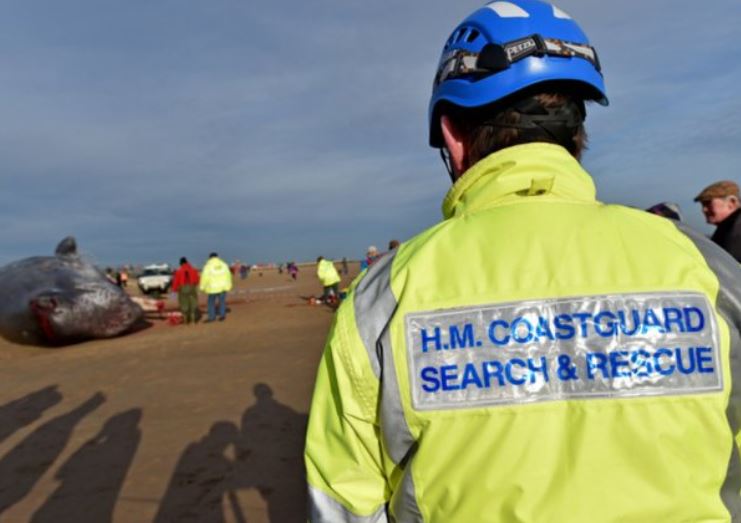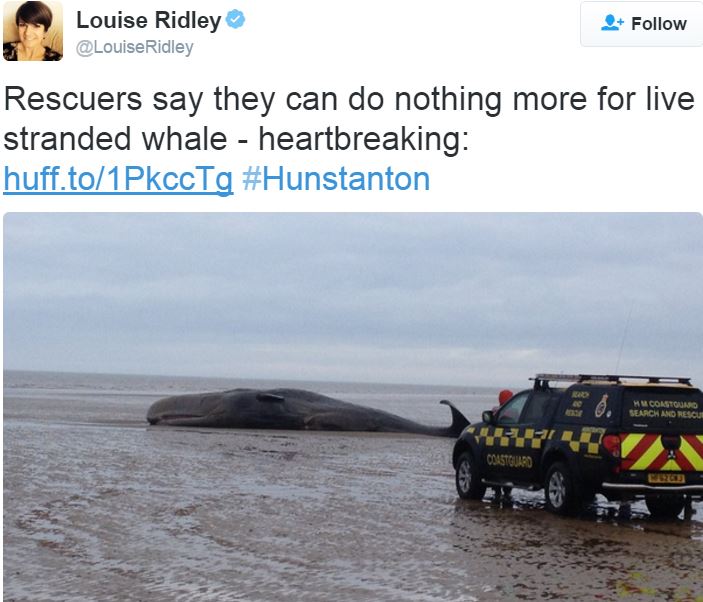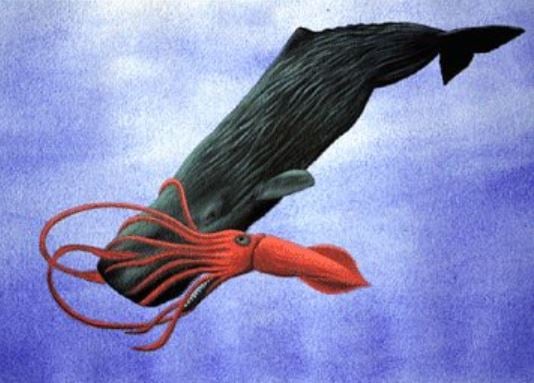The thirty whales that have so far died in the North Sea waters and beaches appear to have been hunting squid and unintentionally ended up in shallow waters and became stranded, Dr. Peter Evans, a whale expert from the Sea Watch Foundation said. He has ruled out several other possibilities.
Six whales washed up and died on the east coast of England in Hunstanton and Skegness. The rest were found on beaches in the Netherlands, Germany and France.
The mass deaths have been a mystery, with suggestions from lay people and some scientists that the Earth’s magnetic field may have been affected by increased activity from the Sun, collisions with boats, an epidemic, escape attempts from predators such as orcas (killer whales), or ship or submarine noises that interfere with the animals’ ability to use their hearing to chase prey (echolocation).
 It seems that this time the mass whale deaths are not ‘man’s fault’. (Image: twitter.com/DiplyNews)
It seems that this time the mass whale deaths are not ‘man’s fault’. (Image: twitter.com/DiplyNews)
Sperm whale deaths not caused by man-made object
The Sea Watch Foundation has ruled out man-made objects that might have interfered with the whales’ ability to navigate as possible culprits.
Dr. Evans, who is the director of the Sea Watch Foundation, said in an interview with the BBC:
“We’ve now had 30 animals stranded around the southern part of the North Sea – making it the biggest we’ve ever had.”
“The animals which were first stranded in Holland had quite a lot of a particular species of squid in their stomachs – which they can catch, up in the Norwegian Deep.”
He believes they headed towards the southern regions of the North Sea, probably chasing shoals of squid.
Dr. Evans explained:
“What happens, particularly south of Dogger Bank, is that the depths are much shallower than anything they are accustomed to.”
“They normally live out in very deep waters, about 3,000 metres deep – south of Dogger Bank it’s mainly less than 50 metres – and can be less than 20.”
“I can understand why people look for some human factor that may be causing these strandings, but there is certainly no evidence. Whale strandings occurred as far back as the 16th Century.”
 Paul Fisher posted this picture with the following message today: “Searchers hope latest sperm whale has returned to deep waters as hunt called off.” (Image: twitter.com/PaulFisheredit)
Paul Fisher posted this picture with the following message today: “Searchers hope latest sperm whale has returned to deep waters as hunt called off.” (Image: twitter.com/PaulFisheredit)
According to Dr. Evans, as soon as the whales had swum south of Dogger Bank, their chance of suriving dropped dramatically.
All the sperm whales that died were males. That in itself is not unusual and is no surprise. Female and juvenile sperm whales tend to remain exclusively in tropical waters, while adult males can reach as far as the coasts of Norway or Iceland.
Each time a stranded whale was discovered, rescuers appeared and kept the animal comfortable, in the hope that it would eventually find its way back to deeper waters as soon as the tide came in. Sadly, for these thirty beautiful animals, this did not happen.
Rob Deaville, from the *Cetacean Strandings Investigation, who is currently examining the whale carcasses to determine cause of death, said it was probably better that the animals died as far as their welfare was concerned. They would have been severely injured during their panicked thrashings.
* Cetaceans are marine mammals of the order Cetacea, and include porpoises, dolphins and whales.
Noise from ships undermining killer whales’ ability to thrive
Researchers at the University of Colorado and the University of Washington reported earlier this month that ship noise is bad for killer whales (orcas), and is probably contributing to the high numbers of deaths along the US and Canadian coasts.
When ships pass, their noise messes with the killer whales’ ability to pinpoint and pursue prey – it also makes it harder for them to communicate with each other.
 When a giant 49-foot sperm whale gets stranded on the beach, there is not much rescuers can do for it except to keep humans and pets away and hope it can get to deeper water when the tide comes in. (Image: twitter.com/LouiseRidley)
When a giant 49-foot sperm whale gets stranded on the beach, there is not much rescuers can do for it except to keep humans and pets away and hope it can get to deeper water when the tide comes in. (Image: twitter.com/LouiseRidley)
When the killer whale chases its prey, it emits click sounds and listens to their echoes, this is called echolocation.
The researchers said the growth in commercial shipping has increased twenty-fold over the past fifty years.
Solar activity and whale strandings
Several years ago, scientists discovered a link between the solar cycle and whale strandings. In 2005, researchers at the University of Kiel in Germany found that more whales run aground in the North Sea when solar activity is higher.
They told the BBC that increased solar activity caused disturbance in Earth’s magnetic field. Whales are thought to use our planet’s magnetic field to help them navigate, just like homing pigeons do.
The German scientists wrote in the Journal of Sea Research that the majority of whale strandings from 1712 to 2003 occurred when solar activity was high.
The Sun goes through an 11 year cycle (average) – individual cycle lengths can range from eight to 17 years.
 Stranded whales have been reported in Germany, the Netherlands, France and the UK. (Image: uk.whales.org)
Stranded whales have been reported in Germany, the Netherlands, France and the UK. (Image: uk.whales.org)
Reasons offered for whale strandings and deaths
Several suggestions have been proposed to the whale experts who are currently trying to determine why so many have died in the North Sea this year. Some have already been ruled out:
– The whales were chasing prey and strayed into shallow waters and got stuck. This is currently the most favoured explanation.
– An epidemic is wiping them out.
– Chemicals that were banned in the 1980s – PCBs (polychlorinated biphenyls) – are still present in seawater and are known to be bad for whales and dolphins.
– One got into trouble and the other members of the pod came to the rescue and got into trouble in shallow waters.
– Rough weather could have led them in the wrong direction.
– Shipping and/or submarine noise is either confusing them or making it hard for them to catch food.
 An artist’s depiction of a sperm whale battling with a giant squid – its favourite prey. Whales commonly have battle scars. (Image: news.softpedia.com)
An artist’s depiction of a sperm whale battling with a giant squid – its favourite prey. Whales commonly have battle scars. (Image: news.softpedia.com)
– Solar activity is interfering with Earth’s magnetic field, which in turn affects their ability to navigate.
– Sometimes cetaceans follow other cetacean species, e.g. whales may follow dolphins, and ended up in shallow waters.
– They could have been trying to escape from killer whales, their only natural predator. However, killer whales target juvenile or baby sperm whales, and would never go after adult males.
– They were injured either by collisions with boats or crashing into shallow rocks.
Largest whale stranding ever recorded – Chile
Last year, a massive stranding involving at least 337 sei whales was reported on a southern Chilean beach. Experts say it is probably the largest stranding ever recorded.
Biologist Vreni Haussermann, Ph.D., scientific director of the Huinay Scientific Field Station, said she and other researchers made the discovery in June 2015 during an observation flight over the country’s fjords in the southern Patagonia region.
After collecting and examining whale samples, Dr. Haussermann says she has some conclusions regarding their deaths, and will disclose them after her work has been published in a scientific journal in the near future.
Chilean news agency Terra Chile quoted Dr. Haussermann as saying:
“During the aerial observation it was not possible to get an accurate estimate of the number of skeletons, because of the airplane’s speed and height,” (“Pero la verdad que no buscamos en forma detallada más esqueletos porque durante el vuelo los esqueletos no se pueden ver por la velocidad… y por la altura.”)
Video – Tourist swims with sperm whales
